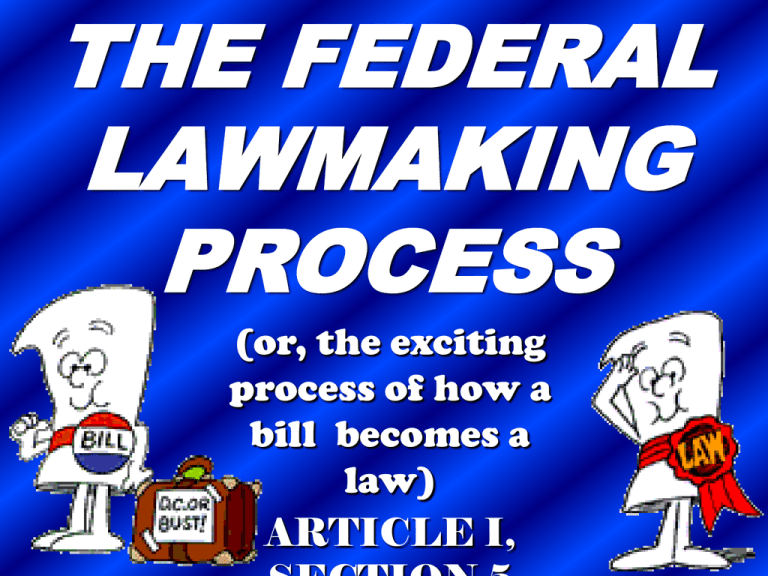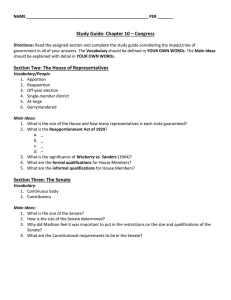Billbecomesalaw
advertisement

THE FEDERAL LAWMAKING PROCESS (or, the exciting process of how a bill becomes a law) ARTICLE I, Once this presentation is complete, you should be able to: • describe the general process of how a bill becomes a law • identify the many different groups involved in the lawmaking process • evaluate the positive and negative aspects of the lawmaking process What is a BILL? A BILL is a draft or idea for a law Who comes up with the ideas for bills? ANYONE You, me, your parents, the President, interest groups, Congress, people How does a bill become a law? It is a long process but once you get the hang of of it, it’s not too confusing! We will be looking at 10 basic steps in the lawmaking process For each step, pay close attention, and take careful and concise notes … and then we will sing PROPOSAL Make July 10 Federal Soccer Day Follow the Soccer Bill 2) House Committee 1) Intro in the House Action 4) Intro in the Senate 5) Senate Committee Action 8) Both houses, sent to President 3) House Floor Action 7) Conference Committee 6) Senate Floor Action 9) Presidential Action 10) Congressional override Follow the Soccer Bill 2) House Committee 1) Intro in the House Action 4) Intro in the Senate 5) Senate Committee Action 8) Both houses, sent to President 3) House Floor Action 7) Conference Committee 6) Senate Floor Action 9) Presidential Action 10) Congressional override NOTE - The lawmaking process may begin in either the Senate or the House of Representatives!! Except for REVENUE, or tax bills - they must begin in the House of Representatives (it’s in the Constitution) 1) A bill is introduced into the House of Representatives by a Representative Follow the Soccer Bill 2) House Committee 1) Intro in the House Action 4) Intro in the Senate 5) Senate Committee Action 8) Both houses, sent to President 3) House Floor Action 7) Conference Committee 6) Senate Floor Action 9) Presidential Action 10) Congressional override 2) Committee Action committees act as filters for bills of common subjects committees investigate the bill Committees can: report the bill to the entire House favorably or unfavorably change or amend the bill kill the bill - “pigeonhole” it Follow the Soccer Bill 2) House Committee 1) Intro in the House Action 4) Intro in the Senate 5) Senate Committee Action 8) Both houses, sent to President 3) House Floor Action 7) Conference Committee 6) Senate Floor Action 9) Presidential Action 10) Congressional override D A V 3) AOn majority The goes (50%+1) to the ofHouse the House Floor must for theBill House Floor, the Representatives can debate,the amend, anditvote on theon bill approve bill action for to move Some interesting tidbits about debate and voting in the House Debate is limited in the House of Representatives Votes are public - not secret Votes are usually taken electronically Follow the Soccer Bill 2) House Committee 1) Intro in the House Action 4) Intro in the Senate 5) Senate Committee Action 8) Both houses, sent to President 3) House Floor Action 7) Conference Committee 6) Senate Floor Action 9) Presidential Action 10) Congressional override 4) A similar bill is introduced into the SENATE by a Senator Follow the Soccer Bill 2) House Committee 1) Intro in the House Action 4) Intro in the Senate 5) Senate Committee Action 8) Both houses, sent to President 3) House Floor Action 7) Conference Committee 6) Senate Floor Action 9) Presidential Action 10) Congressional override 5) Committee Action committees act as filters for bills of common subjects committees investigate the bill Committees can: report the bill to the entire Senate favorably or unfavorably change or amend the bill kill the bill - “pigeonhole” it Follow the Soccer Bill 2) House Committee 1) Intro in the House Action 4) Intro in the Senate 5) Senate Committee Action 8) Both houses, sent to President 3) House Floor Action 7) Conference Committee 6) Senate Floor Action 9) Presidential Action 10) Congressional override 6) The billcan goes to the Senate and Floor for debate, amend, vote IfSenators the bill receives a majority (50%+1) action on thewill billmove on vote, the bill D A V Some interesting tidbits of info about debating and voting in the Senate • Voting is done usually by roll call, public • Debate in the Senate is UNLIMITED! • Senators can talk for as long as they possibly can - this is called a filibuster What is the record? 24 hours and 18 minutes Some interesting tidbits of info about debating and voting in the Senate • Senators can add different laws to the bills being discussed. • These additions are often called riders • Such bills are referred to as CHRISTMAS TREE BILLS Follow the Soccer Bill 2) House Committee 1) Intro in the House Action 4) Intro in the Senate 5) Senate Committee Action 8) Both houses, sent to President 3) House Floor Action 7) Conference Committee 6) Senate Floor Action 9) Presidential Action 10) Congressional override 7) If the bill passed by the Senate is DIFFERENT than the bill passed by the House (it usually is), the bill goes to a Conference Committee • The Conference Committee is made up of leaders of the House and Senate Standing Committees that investigated the bill • They will meet and try to iron out the differences and pass the bill through both houses again LOBBYISTS • Representatives of special interests groups who meet with members of both houses to try to persuade them to vote for specific programs • Some are full time, some are hired out • Registered Federal Lobbyist Database Follow the Soccer Bill 2) House Committee 1) Intro in the House Action 4) Intro in the Senate 5) Senate Committee Action 8) Both houses, sent to President 3) House Floor Action 7) Conference Committee 6) Senate Floor Action 9) Presidential Action 10) Congressional override 8) After the Conference Committee, the bill is quickly passed through both houses of Congress….. 8) and the ENROLLED bill is signed by both presiding officers and sent to the White House Follow the Soccer Bill 2) House Committee 1) Intro in the House Action 4) Intro in the Senate 5) Senate Committee Action 8) Both houses, sent to President 3) House Floor Action 7) Conference Committee 6) Senate Floor Action 9) Presidential Action 10) Congressional override 9) Presidential Action – four options The President can sign the bill the bill becomes law The President can choose to not sign the bill within 10 days the bill becomes a law (without the support of the President) The President can veto the bill the bill goes back to Congress The President can make a pocket veto if the President does not sign the bill, and Congress adjourns within 10 days, the bill DIES!! Follow2)the Schwieters Bill House 3) House Floor Committee 1) Intro in the House Action 4) Intro in the Senate 5) Senate Committee Action 8) Both houses, sent to President Action 7) Conference Committee 6) Senate Floor Action 9) Presidential Action 10) Congressional override 10) If the President VETOES the bill, THE BILL IS NOT DEAD it can still become a law IF both houses override the veto with a 2/3 majority vote 2/3 2/3 Where can the Soccer bill die? 2) House 3) House Floor Committee 1) Intro in the House Action 4) Intro in the Senate 5) Senate Committee Action 8) Both houses, sent to President Action 7) Conference Committee 6) Senate Floor Action 9) Presidential Action 10) Congressional override Some lawmaking statistics • In the 106th Congress (1999-2000), 5,815 bills were introduced in the House, 3,343 in the Senate • 580 bills were enacted or passed both houses during the 106th Congress • President Clinton vetoed 12 pieces of legislation (11 regular, 1 pocket) • Congress was able to override 0 of President Clinton’s vetoes





